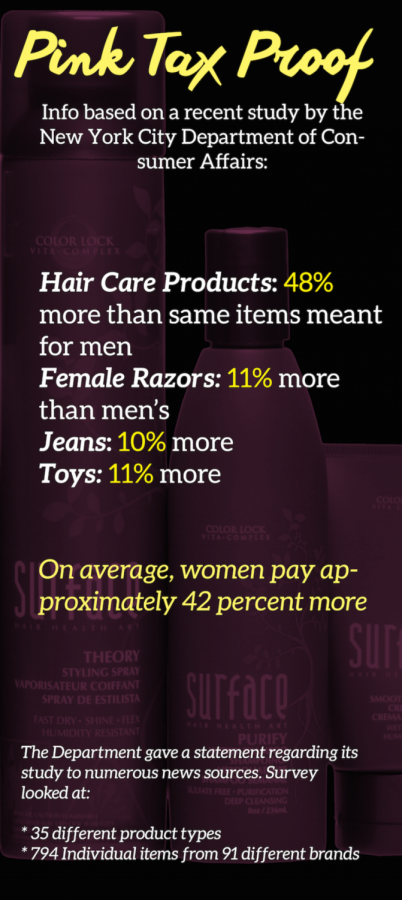Pink Tax plagues consumer America with higher prices on feminine products in popular retail locations
March 8, 2016
Many identical products have drastically different prices depending on their intended gender market, a pricing issue that has been occurring almost indefinitely. Recent attention by consumers and news sources has resulted in the phrase “Pink Tax,” to describe the unofficial “tax” that raises the price of many female products.
“The Pink Tax, although it may not be an actual tax, is a method of exploitation used by corporate entities towards women,” said junior political science major, Johnny Dragon.
“By capitalizing on the concrete gender norms in the United States, companies can jack up the prices of products that women are told they ‘need.’ The gender norms accepted in our country tell women that they need products such as razors, makeup and bras in order to meet our society’s expectations of what women should look and be like,” Dragon said.
Despite the common notion that only feminine hygiene items, such as tampons and pads, are taxed at a higher rate, other everyday items such as shampoo, razors, clothes, toys and many other items are charged at substantially higher rates than men’s items.
A recent study by the New York City Department of Consumer Affairs found that hair care products cost on average, 48 percent more than the same items meant for men. The Department gave a statement regarding its study to numerous news sources. “The goal of the study was to estimate the price differences male and female shoppers face when buying the same types of items. It looked at 35 different product types, examining 794 individual items from 91 different brands.”
This display of sexism infuriates women all across the world. In the past year, countless mainstream media sources wrote about the drastic price ranges from male to female products. Reputable news outlets covering this issue include the New York Times, Forbes, Fox News and CNN.
“Women are forced to pay for these products or else they face scrutiny within the patriarchal culture in which we live,” Dragon continued.
“The Pink Tax increases inequality between men and women, because men do not have the same pressure to buy such products to maintain their physical appearance. For example, the rugged look is socially acceptable for men, so they don’t have to shave nearly as often. Essentially, the Pink Tax capitalizes on the insecurities of women, which are reinforced by the Pink Tax. It is one big cycle that takes money from women and puts it into the pockets of patriarchal corporate executives.”
Many find the Pink Tax exceptionally outrageous given the modern dichotomy of salaries earned by men and women. Most of the time, women pay more and make less.
“Simply put, the Pink Tax is unfair to women,” senior Kristian Stefanides said. “Not only are most women in the country paid less than mens’, but many products geared toward women are more expensive than men’s, which is unacceptable. As women, we can choose to purchase men’s products to save money. However, we shouldn’t have to. In that sense, companies should make prices of women’s products equal to mens’, so that women, too, are able to buy what they want, not just what is cheaper.”
Augustine Horner, a junior political science major, echoed this dissatisfaction. “The pink tax is fueled by the fact that manufacturers can charge more on identical products that are marked specifically towards women, but just because it can be done does not mean that it should be,” Horner said.
“There are two strategies that people can employ to put an end to the pink tax: stop buying unfairly priced goods and put pressure on companies that sell the unfairly priced goods. As far as the tampon tax, it is absolutely ridiculous that tampons should be considered a luxury items. Having your period is not a choice. Therefore, tampons should not be considered a luxury item. It is baffling that this is even a debate in this day and age.”
Forbes Magazine has explored Pink Tax in detail, listing the specific sites notorious for charging the extra buck. Target, Wal-Mart, Levis and Walgreens are examples of retail stores that charge more and increase the products made for females anywhere from 23 percent to 87 percent.
Target charged 87 percent more for a pink helmet, Levis charged 29 percent more for women’s jeans and Walgreens charged 23 percent more for women’s razor cartridges and 35 percent more for women’s shampoo.
Many industries also engage in the unnecessary gendering of items in order to charge more. Anything from ear plugs to generic medicines are painted pink and as a result, priced at a higher rate.
Forbes also reveals that CVS takes part in the tax with an average of 14.7 percent more for personal care products. Even ‘Babies R Us’ has an 11.2 percent price difference on some of their products.
“Women need to be more informed about this,” said sophomore Cailin Ryan who is affected by the tax when shopping at CVS. “It definitely upset me, and I would like to see it changed.”
Graphic courtesy of Caroline Foley











